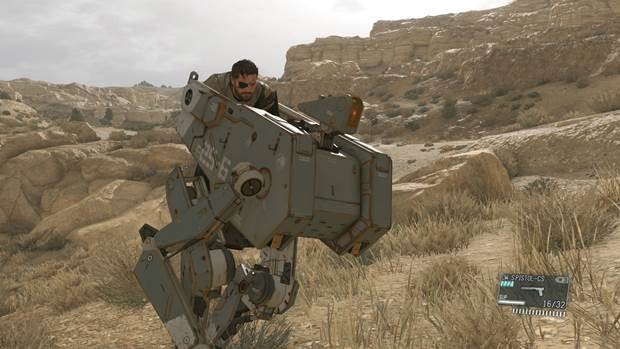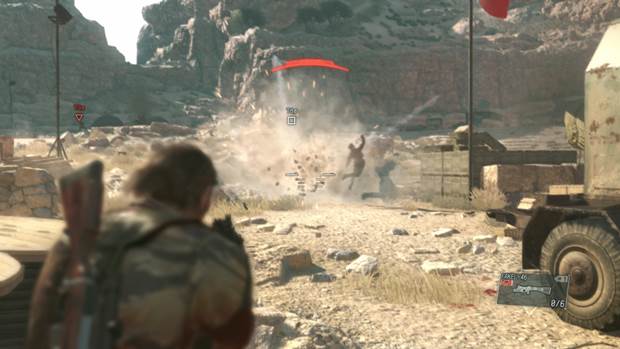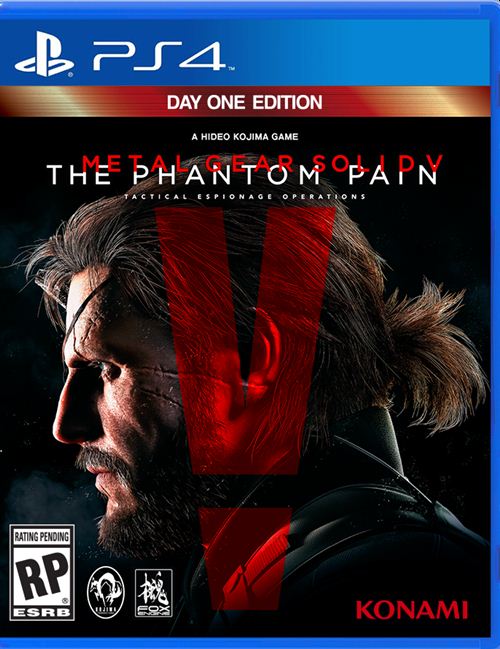
As a person that’s not much of a fan of the Metal Gear Solid series, my interest in Konami’s upcoming title The Phantom Pain, was at a minimum to say the least. My past experiences with the series root way back the 90s on the original PlayStation, which at the time did grip my attention. Metal Gear Solid was unlike any other game on the market back then. An in-depth movie-like storyline, revolutionary graphics, and an iconic character that’s known by just about every player on the planet.
After tipping my toes back in the water and picking up Metal Gear Revengeance and Metal Gear Solid: Ground Zeroes on the PC, my interest began to surge once again. Metal Gear Solid has always crossed my mind as a series that requires you to have past knowledge of the previous titles. But there’s just so many. As far as I know about the series and I’m pretty sure fans will slaughter me for this, there’s cyber-ninjas, an ageless spy, a clone of the main protagonist who’s some kind of boss, a nuclear weapon, and a guy named Raiden who nobody seems to like. Raise your pitchforks.
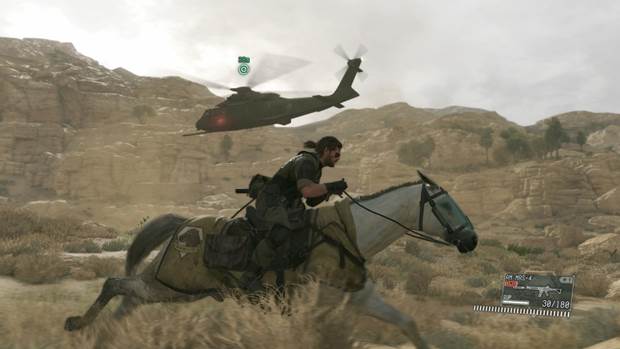
"Being given access to the PlayStation4 version of The Phantom Pain in which the game was 80% complete, there's not much that can be done to the game in terms of major gameplay elements, mission structure, and graphical decisions. From this point onwards it's more or less optimization, finishing the core aspects of the main game, and running through bugs and glitches."
Most recently I was given a hands-on preview session with Metal Gear Solid 5: The Phantom Pain. As most gamers are well aware, private preview sessions tend to consist of scripted set-pieces shoved in to a two-three hour playthrough session, intent on highlighting the best parts of a game. This is no secret. But how exactly does this work in a semi-open-world game that plays on the basis of character choice and the missions they decide to take part in, all the while attempting to deliver an intricate storyline that spans across decades? Well, it doesn’t. That’s not going to work.
Being given access to the PlayStation 4 version of The Phantom Pain in which the game was 80% complete, there’s not much that can be done to the game in terms of major gameplay elements, mission structure, and graphical decisions. From this point onwards it’s more or less optimization, finishing the core aspects of the main game, and running through bugs and glitches. Safe to say it’s essentially complete and this is the experience you are going to receive once the game launches.
As stated previously, my interest within the game is a bare minimum. It’s lackluster, it’s not on my radar, I know nothing of the main protagonist besides his name and even then I’m still not entirely sure. Big Boss or Snake? This isn’t by choice and sadly I wish I knew more, I fell off the bandwagon. Forgive me. So I’m at Konami’s office, the PlayStation 4’s at a distance, I’m sipping lemonade, chewing through croissants, and speaking to other journalists about an underground pub within the gritty streets of central London. I’m having a pretty good time.
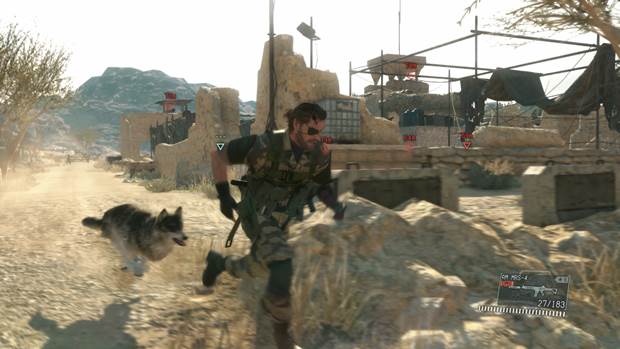
"In terms of story telling, sound design and graphics, everything moulds together perfectly and delivers something that's for lack of a better word, jaw-dropping."
During my first hour with the game the first thing that stood out to me the most was in its presentation. The game’s prologue was an hour long in itself, and where some games have a tendency to overstay their welcome and inflict insulting tutorials of the game’s mechanics in order to justify content filler, The Phantom Pain completely throws this out the window. Many people within this industry have began throwing out the word “Cinematic”. To some it’s a justification for hardware limitations, via the use of screen cropping and daft aspect ratios. But to others it’s a method of character interaction by the use of dialogue choices and on-screen button prompts.
They’re both wrong. Hideo Kojima has nailed it. Now I understand why they call him a genius. Everything within the presentation of the game screams cinematic, none of which relate to the aforementioned practices. In terms of story telling, sound design and graphics, everything moulds together perfectly and delivers something that’s for lack of a better word, jaw-dropping. Despite the game still being months away from release, it already carries a great amount of polish and quality that would put most recently released titles to shame.
For anybody out there who’s curious about the game but doesn’t have much knowledge on the characters or lore of the series, you need not worry. Two years back when Hideo Kojima released the first trailer and gameplay demo, we were greeted to a strange supernatural-horror scene that involved a man covered in bandages, helping Snake escape from a hospital.
"If there's one thing in particular that I'm certain gamers will look back on, near the end of this console generation, it will be the prologue of The Phantom Pain."
Snake’s spent the last nine years in a coma and now he’s awoken, he may in fact be better off dead. Why? because he’s got one arm, 108 foreign bodies inside him, shrapnel remains piercing his heart and skull, oh let’s not forget the world wants him dead.
The most ironic thing about all of this which spoke to me as a “Semi-Newcomer” to the series, is that my connection with Snake felt justified since neither of us knew anything of the world we were both engaged in. This hospital scene is in fact the opening to the game and if the first five minutes of first-person shock and awe doesn’t reel newcomers in to the game, then my faith in gamers will be lost. Maybe I’m getting old. But again, it’s within the presentation of the game that succeeds on immersion. It’s intense, it’s breathtaking, and it’s full of tension.
If there’s one thing in particular that I’m certain gamers will look back on, near the end of this console generation, it will be the prologue of The Phantom Pain. Something within the game that I thought to be sheer brilliance was in relation to the character himself and to the title of the game. For the past year and half fans of the game have been trying to figure out the meaning behind “The Phantom Pain”.

"Seamlessly combining in-game cutscenes with gameplay, the method of storytelling and character dialogue is nothing short of incredible. Character animations are uncanny and the cinematic camera angles are some of the best I've seen merging traits from both movies and videogames."
It’s brilliant in that it’s metaphorical to Snake’s sense of identity. He has lost limbs, he has lost memories, and he has lost his sense of the world and the changes that’s taken place during his absence. Also suffering from phantom limb syndrome, meaning the ability to feel and gain sensations from limbs that no longer exist, Snake is nothing but a ghost, a phantom if you will.
Determined to reclaim what’s his and resolve the tragedies caused by his foes, along with the emergence of new ones, the game feels really intent on making the both the player and Snake feel like a leader. A Big Boss. This is something that’s apparent in the way allies and key characters interact with Snake through cutscenes and in-game.
Seamlessly combining in-game cutscenes with gameplay, the method of storytelling and character dialogue is nothing short of incredible. Character animations are uncanny and the cinematic camera angles are some of the best I’ve seen merging traits from both movies and videogames. The graphical level that The Phantom Pain carries is phenomenal and it does so without the compromise of actual gameplay.
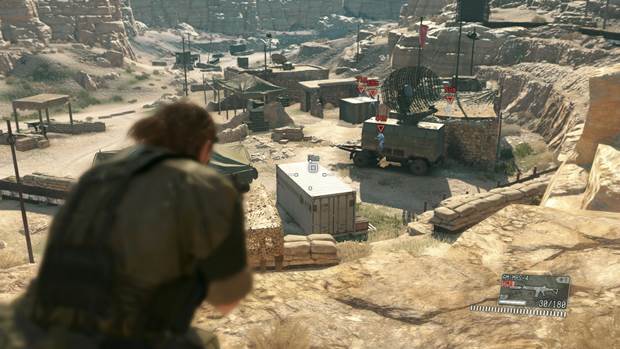
"While not fully open world, the environments being given to the player are quite sizeable, none of which fills empty or barren, hosting a world of convincing life-like characters, fully immersing the player in to its world."
While not fully open world, the environments being given to the player are quite sizeable, none of which fills empty or barren, hosting a world of convincing life-like characters, fully immersing the player in to its world. Where I felt the game held one of its most strongest points was in its factor of immersion. Not once did I feel I was pulled out of the game when having to make adjustments to Snake, aspects of gameplay, or when engaging in the Mother Base features.
Up until this point it hasn’t really been specified as to how Mother Base works exactly. For the most part it’s only been shown through trailers and cutscenes, leaving fans of the series curious as to how this new system works and how it will effect gameplay. It’s best to think of Mother Base as a management system for all of Snake’s weapons, vehicles, skills, comrades, and upgrades. Medical, Support, Combat, Intel, Base, Research and Development, all of which are setup as different departments on-board Mother Base which the player can navigate and train with soldiers.
Rather than being a simple menu system plagued by charts, skill points, and character level requirements like you would find in an RPG of some sort, MGS5 takes a more hands-on approach to developing and managing these systems that make sense from both a gameplay perspective and the things that Snake is required to do in order to better himself and Mother Base. All of this works on a basis of resources and Intel that the player will come across while undertaking missions.

"Prior to a mission or even while during, Snake may receive calls from Mother Base informing him of important contacts that just so happen to be in the area, that may prove to be beneficial for a specific department back at Mother Base."
By using materials found in the game’s environment such as diamonds and metals, Snake can use these as currency that can be invested in to Mother Base for developing new equipment. One thing that’s vastly different about this system when compared to other games that use a resource management system and such as a basis of currency for character development, is that not only are you relying on raw materials to do so, but also other characters within the game.
Prior to a mission or even while during, Snake may receive calls from Mother Base informing him of important contacts that just so happen to be in the area, that may prove to be beneficial for a specific department back at Mother Base. Whether this informant is being held hostage, is undercover, or engaging in a mission themselves will always be a surprise to the player. This recruitment system isn’t just limited to key contacts in the field, no.
Snake can also kidnap enemy soldiers and through the means of the Fulton recovery balloon they will be flown back to Mother Base. Once they’ve reached, Snake will receive a call informing him of their arrival, from here on out it’s down to Mother Base to work their means of…persuasal. This useful and impressive gadget can also be used on sheep, goats and other animals within the area. As entertaining as this feature is in itself, it’s the development system that’s of more benefit to the player. Each character in the game, whether that’s a key contact or enemy soldier contains a list of skills and traits that will make them more suited towards a specific department in Mother Base.
"Everything that MGS5 does, it does so while continuously managing to feel new and dynamic, trying its hardest to present the player with something random and unexpected. And not only does this come in the form of character engagement but also to the structure of the mission itself."
By assigning them to the department of the player’s choosing they will further develop their skills and new upgrades will be available for the player. Weapons, first aid equipment, air support, vehicles drop-offs, costumes, melee combat, the list goes on. During my six hour playtime with the game it was clear I hadn’t even begun to scratch the surface of how much depth and detail had gone in to the implementation of Mother Base.
Everything that MGS5 does, it does so while continuously managing to feel new and dynamic, trying its hardest to present the player with something random and unexpected. And not only does this come in the form of character engagement but also to the structure of the mission itself. The player will decide where they want to go and which missions they wish to undertake. If I could name one aspect about the game that I absolutely adore, it’s the absence of “Gamey” menus.
Whether Snake is on a mission or back at Mother Base, almost everything related to mission Intel, characters, or the upgrade systems in Mother Base is all done through Snake’s iDroid device. It’s a bit like the computer terminal on Batman’s wrists from Rocksteady’s Arkham games. Only it does a whole lot more and proves to be more practical, as opposed to just being a scene-scripted communication device. Extending upon menu choices for characters and mission structure, the iDroid also functions as means to combat and traversal. And no, you can’t melee soldiers in the back of the head then use it as a skateboard.
"The sense of realism in their actions alone placed a very different feeling on me as the player and how I would go about the mission. And while it forced me to play more stealthy, it didn't feel as if it was doing so by force, it was down to common sense."
Appearing in Snake’s view as an holographic interface, the player can browse different options for air support, helicopter pick-ups, scan the area to gain information on targets, and place the mission on pause should they wish to return to Mother Base. Where the game greatly excels in mission structure is down to the element of player choice and how well the NPCs in the game react to their actions. Their behaviour is dynamic in the sense that’s it’s relevant to the mission at-hand.
Whether it’s sub-objectives alongside the primary mission or side missions outside of the primary missions, enemy behaviour does well in feeling natural and non-scripted. Should the player choose to take an approach of stealth, the game dynamically adjusts to the player’s play-style. For instance, where the majority of stealth games would have the player running for their lives should they be spotted by guards, relying on a cool-down meter that fails to make any sense whatsoever with guards re-scripting their prior animations, MGS5 does things differently.
Alerting a guard or enemy soldier won’t spawn a barrage of NPCs running their way with guns blazing, instead the game will react smartly and dynamically meaning guards may choose to approach you solo should they feel brave, or change their minds and call for reinforcements if they feel unmatched. The player’s chosen approach to undertaking missions isn’t just dynamic in the sense that enemy behaviour responds to their actions. As the game utilizes a day and night cycle, either by random or the player’s chosen preference, the enemy’s behaviour responds so in kind.
During a mission in which I undertook during the evening, I was tasked with rescuing one of Snake’s former allies. Where I chose to do so at this specific time, the behavioural traits in my enemies had a natural and plausible sense of believability and change to it. It was grounded so to speak. Scouting them out from far as they lit camp fires and paced back and forth with more aggression, constantly on the look out and upping their guard.
The sense of realism in their actions alone placed a very different feeling on me as the player and how I would go about the mission. And while it forced me to play more stealthy, it didn’t feel as if it was doing so by force, it was down to common sense. Upon rescuing this accomplice, this element of stealth I had now taken on had caused a clash with my natural play-style, that being loud and all guns blazing. The game has an intrusive way of making you think sensibly as the player and what your actions may cause in the long run.
"In the same way the original Metal Gear Solid stood out as a defining factor for Sony's first PlayStation and to that of their later consoles, The Phantom Pain will do the same for this console generation."
Sure I could have gone in with guns at-the-ready and slaughtered everybody in sight, but the chance of reinforcements was something that continuously crossed my mind. Would they come or not? Would I have enough weapons and skill to take them out if they did? Previous missions had been so random that I would never have known either way. The take-away point here is that yes it is possible and the gameplay does so well in accommodating different play-styles that any actions the player chooses to make places them in a position of responsibility as opposed to bad game design. Don’t hate the game if you suck.
As far as next-generation games go, many studios seem intent on how many zombies they can fill across the screen while minimizing actual gameplay mechanics, and trying to deliver cinema experiences in the span of a four session while rehashing last-generation game mechanics without adding anything new. Aside from the indie studios which have no fears in taking risks by the way of new gameplay mechanics, Triple-A studios appear to be running in fear at the very thought of trying anything new, and so have focused their games on realistic graphics. As far as I’m concerned Metal Gear Solid 5: The Phantom Pain is the first next-generation game.
It brings new gameplay mechanics, expands on those from a variety of different genres and brings them in to one fully-fledged game while still upholding a high-level of graphical quality. And this was just a preview of the game, and I sense many more surprises in stock for when the game actually launches. In the same way the original Metal Gear Solid stood out as a defining factor for Sony’s first PlayStation and to that of their later consoles, The Phantom Pain will do the same for this console generation and PC.
This game was previewed on the PlayStation 4.









